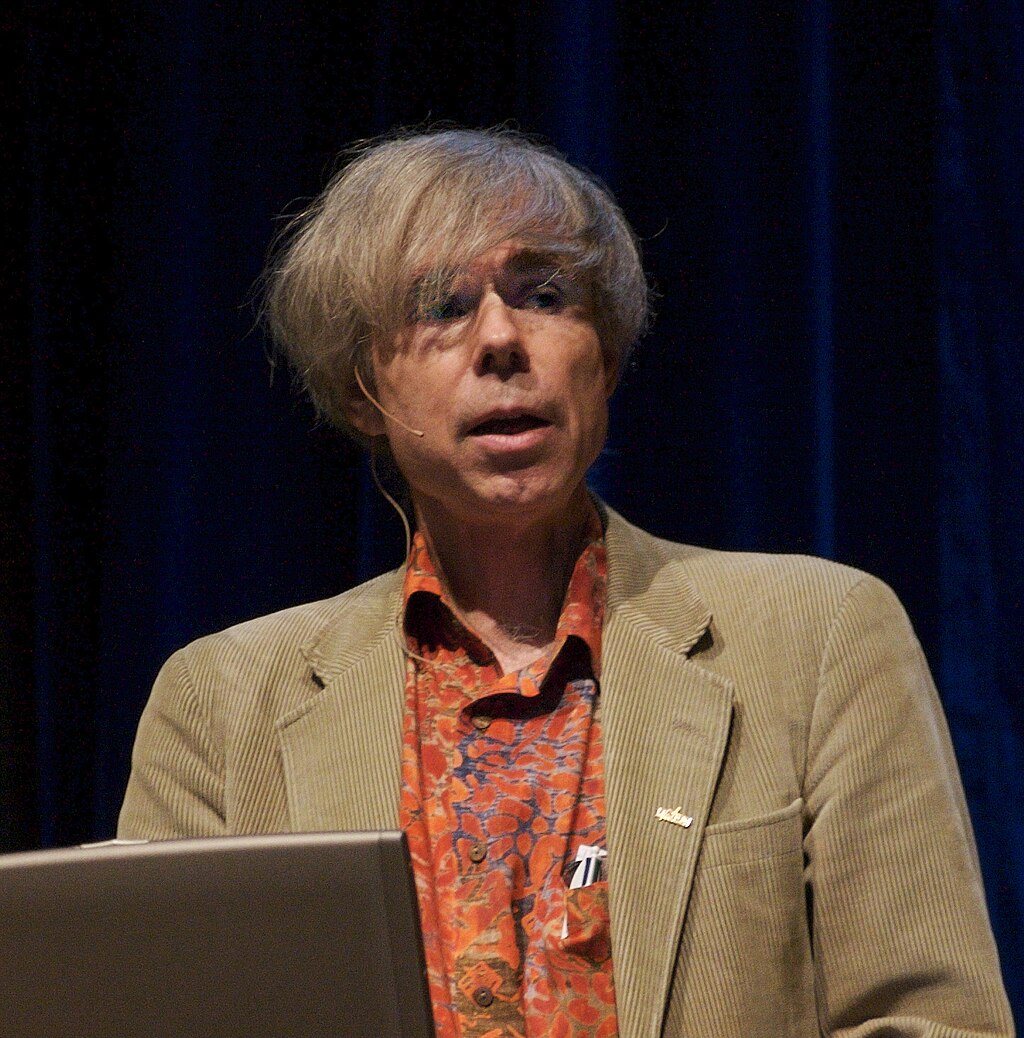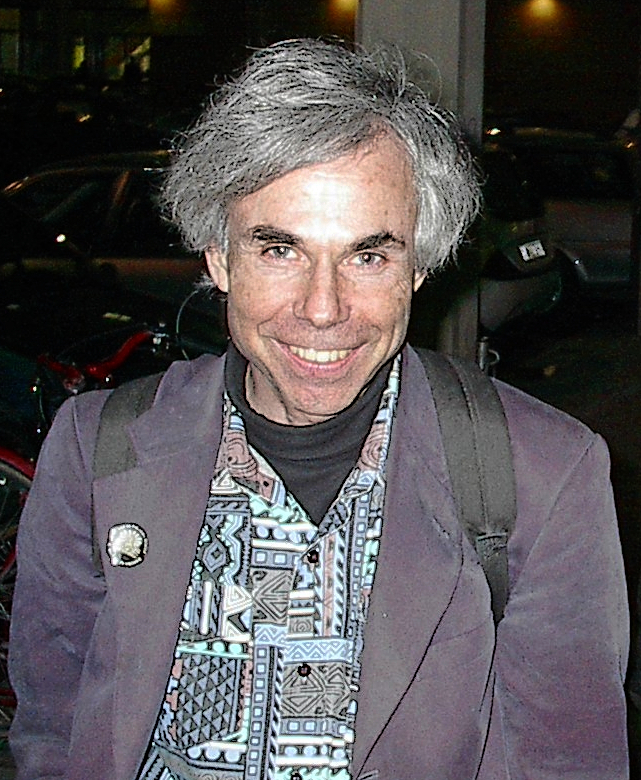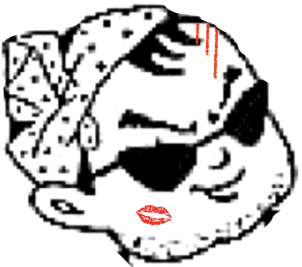
ダグラス・ホフスタッター
Douglas Hofstadter, b.1945
Hofstadter
in 2006
☆
ダグラス・ホフスタッター(Douglas Richard
Hofstadter、1945年2月15日生まれ)は、アメリカの認知科学者、コンピュータ科学者であり、外界との関係における自己の感覚、[3]
[4]意識、類推、奇妙なループ、人工知能、数学と物理学における発見などの概念を研究している。1979年の著書『Gödel, Escher,
Bach: An Eternal Golden
Braid』はピューリッツァー賞(一般ノンフィクション部門)[5][6]、ナショナリズム賞(当時はアメリカン・ブック賞)(科学部門)を受賞した
[7][注 1]。2007年の著書『I Am a Strange
Loop』はロサンゼルス・タイムズ・ブック賞(科学技術部門)を受賞した[8][9][10][11]。
| Douglas Richard Hofstadter
(born February 15, 1945) is an American cognitive and computer
scientist whose research includes concepts such as the sense of self in
relation to the external world,[3][4] consciousness, analogy-making,
strange loops, artificial intelligence, and discovery in mathematics
and physics. His 1979 book Gödel, Escher, Bach: An Eternal Golden Braid
won the Pulitzer Prize for general nonfiction,[5][6] and a National
Book Award (at that time called The American Book Award) for
Science.[7][note 1] His 2007 book I Am a Strange Loop won the Los
Angeles Times Book Prize for Science and Technology.[8][9][10][11] |
ダ
グラス・ホフスタッター(Douglas Richard
Hofstadter、1945年2月15日生まれ)は、アメリカの認知科学者、コンピュータ科学者であり、外界との関係における自己の感覚、[3]
[4]意識、類推、奇妙なループ、人工知能、数学と物理学における発見などの概念を研究している。1979年の著書『Gödel, Escher,
Bach: An Eternal Golden
Braid』はピューリッツァー賞(一般ノンフィクション部門)[5][6]、ナショナリズム賞(当時はアメリカン・ブック賞)(科学部門)を受賞した
[7][注 1]。2007年の著書『I Am a Strange
Loop』はロサンゼルス・タイムズ・ブック賞(科学技術部門)を受賞した[8][9][10][11]。 |
| Early life and education Hofstadter was born in New York City to future Nobel Prize-winning physicist Robert Hofstadter and Nancy Givan Hofstadter.[12] He grew up on the campus of Stanford University, where his father was a professor, and attended the International School of Geneva in 1958–59. He graduated with distinction in mathematics from Stanford University in 1965, and received his Ph.D. in physics[2][13] from the University of Oregon in 1975, where his study of the energy levels of Bloch electrons in a magnetic field led to his discovery of the fractal known as Hofstadter's butterfly.[13] |
生い立ちと教育 ホフスタッターは、後にノーベル賞を受賞する物理学者ロバート・ホフスタッターとナンシー・ギヴァン・ホフスタッターの間にニューヨークで生まれた [12]。父親が教授をしていたスタンフォード大学のキャンパスで育ち、1958年から59年にかけてジュネーブのインターナショナルスクールに通った。 1965年にスタンフォード大学で数学を優秀な成績で卒業し、1975年にオレゴン大学で物理学の博士号を取得した[2][13]。磁場中のブロッホ電子 のエネルギー準位の研究により、ホフスタッターのバタフライとして知られるフラクタル図形を発見した[13]。 |
| Academic career Hofstadter was initially appointed to Indiana University's computer science department faculty in 1977, and at that time he launched his research program in computer modeling of mental processes (which he called "artificial intelligence research", a label he has since dropped in favor of "cognitive science research"). In 1984, he moved to the University of Michigan in Ann Arbor, where he was hired as a professor of psychology and was also appointed to the Walgreen Chair for the Study of Human Understanding. In 1988, Hofstadter returned to IU as College of Arts and Sciences Professor in cognitive science and computer science. He was also appointed adjunct professor of history and philosophy of science, philosophy, comparative literature, and psychology, but has said that his involvement with most of those departments is nominal.[14][15][16] Since 1988, Hofstadter has been the College of Arts and Sciences Distinguished Professor of Cognitive Science and Comparative Literature at Indiana University in Bloomington, where he directs the Center for Research on Concepts and Cognition, which consists of himself and his graduate students, forming the "Fluid Analogies Research Group" (FARG).[17] In 1988, he received the In Praise of Reason award, the Committee for Skeptical Inquiry's highest honor.[18] In 2009, he was elected a Fellow of the American Academy of Arts and Sciences[19] and became a member of the American Philosophical Society.[20] In 2010, he was elected a member of the Royal Society of Sciences in Uppsala, Sweden.[21] |
学者としてのキャリア ホフスタッターは1977年にインディアナ大学のコンピューターサイエンス学部の教授に任命され、その時に精神過程のコンピューターモデリング(彼はこれ を「人工知能研究」と呼んだが、その後このレッテルを外し、「認知科学研究」と呼ぶようになった)の研究プログラムを開始した。1984年、アナーバーの ミシガン大学に移り、心理学教授として採用され、人間理解研究のためのウォルグリーン・チェアにも任命された。 1988年、ホフスタッターはIUに戻り、芸術科学大学教授として認知科学とコンピュータ科学を教えた。彼はまた、科学史と科学哲学、哲学、比較文学、心 理学の非常勤教授にも任命されたが、これらの学部のほとんどとの関わりは名目的なものだと述べている[14][15][16]。 1988年以来、ホフスタッターはブルーミントンにあるインディアナ大学の芸術科学大学特別教授として認知科学と比較文学を研究しており、自身と大学院生 からなる「概念と認知の研究センター」(Center for Research on Concepts and Cognition)を指導している。 [17]1988年、懐疑的探究委員会(Committee for Skeptical Inquiry)の最高栄誉賞であるIn Praise of Reason賞を受賞[18]。2009年、アメリカ芸術科学アカデミーのフェローに選出され[19]、アメリカ哲学協会の会員となった[20]。 2010年、スウェーデンのウプサラ王立科学協会の会員に選出された[21]。 |
| Work and publications At the University of Michigan and Indiana University, Hofstadter and Melanie Mitchell coauthored a computational model of "high-level perception"—Copycat—and several other models of analogy-making and cognition, including the Tabletop project, co-developed with Robert M. French.[22] The Letter Spirit project, implemented by Gary McGraw and John Rehling, aims to model artistic creativity by designing stylistically uniform "gridfonts" (typefaces limited to a grid). Other more recent models include Phaeaco (implemented by Harry Foundalis) and SeqSee (Abhijit Mahabal), which model high-level perception and analogy-making in the microdomains of Bongard problems and number sequences, respectively, as well as George (Francisco Lara-Dammer), which models the processes of perception and discovery in triangle geometry.[23][24][25] Hofstadter's thesis about consciousness, first expressed in Gödel, Escher, Bach but also present in several of his later books, is that it is "an emergent consequence of seething lower-level activity in the brain."[citation needed] In Gödel, Escher, Bach he draws an analogy between the social organization of a colony of ants and the mind seen as a coherent "colony" of neurons. In particular, Hofstadter claims that our sense of having (or being) an "I" comes from the abstract pattern he terms a "strange loop", an abstract cousin of such concrete phenomena as audio and video feedback that Hofstadter has defined as "a level-crossing feedback loop". The prototypical example of a strange loop is the self-referential structure at the core of Gödel's incompleteness theorems. Hofstadter's 2007 book I Am a Strange Loop carries his vision of consciousness considerably further, including the idea that each human "I" is distributed over numerous brains, rather than being limited to one.[26] Le Ton beau de Marot: In Praise of the Music of Language is a long book devoted to language and translation, especially poetry translation, and one of its leitmotifs is a set of 88 translations of "Ma Mignonne", a highly constrained poem by 16th-century French poet Clément Marot. In this book, Hofstadter jokingly describes himself as "pilingual" (meaning that the sum total of the varying degrees of mastery of all the languages that he has studied comes to 3.14159 ...), as well as an "oligoglot" (someone who speaks "a few" languages).[27][28] In 1999, the bicentennial year of the Russian poet and writer Alexander Pushkin, Hofstadter published a verse translation of Pushkin's classic novel-in-verse Eugene Onegin. He has translated other poems and two novels: La Chamade (That Mad Ache) by Françoise Sagan, and La Scoperta dell'Alba (The Discovery of Dawn) by Walter Veltroni, the then-head of the Partito Democratico in Italy. The Discovery of Dawn was published in 2007, and That Mad Ache was published in 2009, bound together with Hofstadter's essay "Translator, Trader: An Essay on the Pleasantly Pervasive Paradoxes of Translation".[citation needed] |
業績と出版物 ミシガン大学とインディアナ大学では、ホフスタッターとメラニー・ミッチェルが「ハイレベル知覚」の計算モデルであるCopycatを共著で発表している ほか、ロバート・M・フレンチと共同開発したTabletopプロジェクトなど、類推と認知のモデルをいくつか発表している[22]。ゲイリー・マグロー とジョン・レーリングが実装したLetter Spiritプロジェクトは、スタイル的に統一された「グリッドフォント」(グリッドに限定された書体)をデザインすることによって、芸術的創造性をモデ ル化することを目指している。他のより最近のモデルには、Phaeaco(Harry Foundalisが実装)とSeqSee(Abhijit Mahabal)があり、それぞれボンガード問題と数列のミクロ領域における高レベルの知覚と類推をモデル化している。また、三角形幾何学における知覚と 発見のプロセスをモデル化したGeorge(Francisco Lara-Dammer)もある[23][24][25]。 ゲーデル、エッシャー、バッハ』の中で最初に表明されたが、それ以降のいくつかの著書にも登場するホフスタッターの意識に関するテーゼは、意識は「脳内の 湧き上がるような低レベルの活動の創発的な結果」であるというものである[要出典]。特にホフスタッターは、私たちが「私」を持っている(あるいは「私」 である)という感覚は、彼が「奇妙なループ」と呼ぶ抽象的なパターンに由来すると主張している。この抽象的なパターンは、ホフスタッターが「レベル交差 フィードバックループ」と定義した、オーディオやビデオのフィードバックのような具体的な現象と同類である。奇妙なループの典型例は、ゲーデルの不完全性 定理の核心にある自己参照構造である。ホフスタッターの2007年の著書『I Am a Strange Loop』では、人間の「私」は1つの脳に限定されるのではなく、多数の脳に分散して存在するという考えを含め、意識に関する彼のヴィジョンをかなり推し 進めている[26]: Le Ton beau de Marot: In Praise of the Music of Language』は、言語と翻訳、特に詩の翻訳に捧げられた長い本であり、16世紀フランスの詩人クレマン・マロットの非常に制約の多い詩である 「Ma Mignonne 」の88の翻訳がそのモチーフの一つとなっている。この本の中でホフスタッターは、自分自身のことを「ピリンガル」(彼が学んだすべての言語の習得度の合 計が3.14159になるという意味)であり、「オリゴグロット」(「いくつかの」言語を話す人)であると冗談めかして述べている[27][28]。 ロシアの詩人であり作家であるアレクサンドル・プーシキン生誕200周年にあたる1999年、ホフスタッターはプーシキンの代表作である『オイゲーヌ・オ ネーギン』の詩訳を出版した。他にも詩と2冊の小説を翻訳している: フランソワーズ・サガンの『La Chamade(あの狂おしい痛み)』と、当時イタリアの党民主党首だったウォルター・ヴェルトローニの『La Scoperta dell'Alba(夜明けの発見)』である。夜明けの発見』は2007年に、『あの狂おしい痛み』は2009年に出版され、ホフスタッターのエッセイ 『翻訳者、トレーダー』と一緒に装丁された: また、2009年には、ホフスタッターのエッセイ『翻訳者、貿易商:翻訳がもたらす快い逆説に関するエッセイ』と一緒に出版された[要出典]。 |
| Hofstadter's Law Main article: Hofstadter's Law Hofstadter's Law is "It always takes longer than you expect, even when you take into account Hofstadter's Law." The law is stated in Gödel, Escher, Bach. |
ホフスタッターの法則 主な記事 ホフスタッターの法則 ホフスタッターの法則とは、「ホフスタッターの法則を考慮しても、常に予想以上に時間がかかる 」というものである。この法則は『ゲーデル、エッシャー、バッハ』の中で述べられている。 |
| Students Hofstadter's former Ph.D. students[29] include (with dissertation title): David Chalmers – Toward a Theory of Consciousness Bob French – Tabletop: An Emergent, Stochastic Model of Analogy-Making Gary McGraw – Letter Spirit (Part One): Emergent High-level Perception of Letters Using Fluid Concepts Melanie Mitchell – Copycat: A Computer Model of High-Level Perception and Conceptual Slippage in Analogy-making |
学生たち ホフスタッターのかつての博士課程の学生[29]には、以下のような者がいる(論文のタイトルを付記): デイヴィッド・チャルマーズ - 意識の理論に向けて ボブ・フレンチ - テーブルトップ: アナロジー・メイキングの創発的、確率的モデル Gary McGraw - 文字の精神(パート1): 流体概念を用いた文字の創発的高度知覚 メラニー・ミッチェル - 模倣犯: 類推における高レベルの知覚と概念のずれのコンピュータモデル |
Public image Hofstadter in Bologna, Italy, in 2002 Hofstadter has said that he feels "uncomfortable with the nerd culture that centers on computers". He admits that "a large fraction [of his audience] seems to be those who are fascinated by technology", but when it was suggested that his work "has inspired many students to begin careers in computing and artificial intelligence" he replied that he was pleased about that, but that he himself has "no interest in computers".[30][31] In that interview he also mentioned a course he has twice given at Indiana University, in which he took a "skeptical look at a number of highly touted AI projects and overall approaches".[16] For example, upon the defeat of Garry Kasparov by Deep Blue, he commented: "It was a watershed event, but it doesn't have to do with computers becoming intelligent."[32] In his book Metamagical Themas, he says that "in this day and age, how can anyone fascinated by creativity and beauty fail to see in computers the ultimate tool for exploring their essence?"[33] In 1988, Dutch director Piet Hoenderdos created a docudrama about Hofstadter and his ideas, Victim of the Brain, based on The Mind's I. It includes interviews with Hofstadter about his work.[34] Provoked by predictions of a technological singularity (a hypothetical moment in the future of humanity when a self-reinforcing, runaway development of artificial intelligence causes a radical change in technology and culture), Hofstadter has both organized and participated in several public discussions of the topic. At Indiana University in 1999 he organized such a symposium, and in April 2000, he organized a larger symposium titled "Spiritual Robots" at Stanford University, in which he moderated a panel consisting of Ray Kurzweil, Hans Moravec, Kevin Kelly, Ralph Merkle, Bill Joy, Frank Drake, John Holland and John Koza. Hofstadter was also an invited panelist at the first Singularity Summit, held at Stanford in May 2006. Hofstadter expressed doubt that the singularity will occur in the foreseeable future.[35][36][37][38][39][40] In a 2023 interview, Hofstadter said that rapid progress in AI made some of his "core beliefs" about AI's limitations "collapse".[41][42] Hinting at an AI takeover, he added that human beings may soon be eclipsed by "something else that is far more intelligent and will become incomprehensible to us".[43][44] |
パブリックイメージ 2002年、イタリア・ボローニャにて。 ホフスタッターは「コンピューターを中心としたオタク文化に違和感を覚える」と語っている。彼は「(彼の読者の)大部分はテクノロジーに魅了された人たち のようだ」と認めているが、彼の研究が「多くの学生にコンピューティングや人工知能のキャリアを始めるきっかけを与えた」と示唆されたとき、彼はそのこと は喜ばしいが、彼自身は「コンピュータに興味がない」と答えた[30][31]。 [30][31]また、そのインタビューの中で、彼はインディアナ大学で2度行った講座についても触れており、その講座では「非常に注目されている数多く のAIプロジェクトや全体的なアプローチに対して懐疑的な見方」をしている[16]。例えば、ディープ・ブルーによってガルリ・カスパロフが敗北した際、 彼はこうコメントしている: 彼の著書『Metamagical Themas』では、「現代において、創造性と美に魅了された人が、その本質を探求する究極のツールをコンピュータに見いださないはずがない」と述べてい る[33]。 1988年、オランダの映画監督ピート・ホーエンドスは、『The Mind's I』に基づいて、ホフスタッターと彼の思想についてのドキュメンタリードラマ『Victim of the Brain』を制作した。 技術的特異点(人類の未来において、人工知能の自己強化的な暴走的発展が技術と文化の根本的な変化を引き起こす仮想的な瞬間)の予測に誘発され、ホフス タッターはこのテーマに関するいくつかの公開討論を組織し、また参加した。1999年にはインディアナ大学でそのようなシンポジウムを企画し、2000年 4月にはスタンフォード大学で「スピリチュアル・ロボット」と題する大規模なシンポジウムを企画し、レイ・カーツワイル、ハンス・モラヴェック、ケヴィ ン・ケリー、ラルフ・マークル、ビル・ジョイ、フランク・ドレイク、ジョン・ホランド、ジョン・コザからなるパネルの司会を務めた。ホフスタッターは 2006年5月にスタンフォードで開催された第1回シンギュラリティ・サミットにも招待パネリストとして参加した。ホフスタッターは、シンギュラリティが 予見可能な将来に起こることに疑問を表明している[35][36][37][38][39][40]。 2023年のインタヴューでホフスタッターは、AIの急速な進歩によって、AIの限界についての彼の「核心的な信念」のいくつかが「崩壊」したと述べた [41][42]。 AIによる乗っ取りをほのめかしながら、彼は、人類は近いうちに「はるかに知的で、われわれには理解できなくなる何か別のもの」に駆逐されるかもしれない と付け加えた[43][44]。 |
| Columnist When Martin Gardner retired from writing his "Mathematical Games" column for Scientific American magazine, Hofstadter succeeded him in 1981–83 with a column titled Metamagical Themas (an anagram of "Mathematical Games"). An idea he introduced in one of these columns was the concept of "Reviews of This Book", a book containing nothing but cross-referenced reviews of itself that has an online implementation.[45] One of Hofstadter's columns in Scientific American concerned the damaging effects of sexist language, and two chapters of his book Metamagical Themas are devoted to that topic, one of which is a biting analogy-based satire, "A Person Paper on Purity in Language" (1985), in which the reader's presumed revulsion at racism and racist language is used as a lever to motivate an analogous revulsion at sexism and sexist language; Hofstadter published it under the pseudonym William Satire, an allusion to William Safire.[46] Another column reported on the discoveries made by University of Michigan professor Robert Axelrod in his computer tournament pitting many iterated prisoner's dilemma strategies against each other, and a follow-up column discussed a similar tournament that Hofstadter and his graduate student Marek Lugowski organized.[citation needed] The "Metamagical Themas" columns ranged over many themes, including patterns in Frédéric Chopin's piano music (particularly his études), the concept of superrationality (choosing to cooperate when the other party/adversary is assumed to be equally intelligent as oneself), and the self-modifying game of Nomic, based on the way the legal system modifies itself, and developed by philosopher Peter Suber.[47] |
コラムニスト マーティン・ガードナーが『サイエンティフィック・アメリカン』誌のコラム「数学的ゲーム」の執筆を引退すると、ホフスタッターは1981年から83年に かけて、彼の後任として「メタマジカル・テマス」(「数学的ゲーム」のアナグラム)と題するコラムを執筆した。これらのコラムの中で彼が紹介したアイデア は、「この本のレビュー」というコンセプトであった。 [そのうちのひとつは、人種差別と人種主義的な言葉に対する読者の反発を、性差別と性差別的な言葉に対する反発を引き起こすためのテコとして利用する、痛 烈な類似に基づく風刺である「A Person Paper on Purity in Language」(1985年)である; ホフスタッターは、ウィリアム・サファイアにちなんで、ウィリアム・サタイアというペンネームでこの本を出版した。 [46] 別のコラムでは、ミシガン大学のロバート・アクセルロッド教授が、多くの囚人のジレンマ戦略の反復を互いに競わせるコンピュータ・トーナメントで発見した ことを報告し、続くコラムでは、ホフスタッターと大学院生のマレク・ルゴウスキーが主催した同様のトーナメントについて論じた。 [メタマジカル・テマス」コラムでは、フレデリック・ショパンのピアノ曲(特に彼のエチュード)におけるパターン、超合理性(相手/敵対者が自分と同等の 知性を持っていると想定される場合に協力を選択すること)の概念、哲学者ピーター・スーバーによって開発された、法制度がそれ自身を修正する方法に基づく ノミックの自己修正ゲームなど、多くのテーマに及んだ[47]。 |
| Personal life Hofstadter was married to Carol Ann Brush until her death. They met in Bloomington, and married in Ann Arbor in 1985. They had two children. Carol died in 1993 from the sudden onset of a brain tumor, glioblastoma multiforme, when their children were young. The Carol Ann Brush Hofstadter Memorial Scholarship for Bologna-bound Indiana University students was established in 1996 in her name.[48] Hofstadter's book Le Ton beau de Marot is dedicated to their two children and its dedication reads "To M. & D., living sparks of their Mommy's soul". In 2010, Hofstadter met his second wife, Baofen Lin, in a cha-cha-cha class. They married in 2012 in Bloomington.[49][50] Hofstadter has composed pieces for piano and for piano and voice. He created an audio CD, DRH/JJ, of these compositions performed mostly by pianist Jane Jackson, with a few performed by Brian Jones, Dafna Barenboim, Gitanjali Mathur, and Hofstadter.[51] The dedication for I Am A Strange Loop is: "To my sister Laura, who can understand, and to our sister Molly, who cannot."[52] Hofstadter explains in the preface that his younger sister Molly never developed the ability to speak or understand language.[53] As a consequence of his attitudes about consciousness and empathy, Hofstadter became a vegetarian in his teenage years, and has remained primarily so since that time.[54][55] |
人格 ホフスタッターはキャロル・アン・ブラッシュと亡くなるまで結婚していた。ブルーミントンで出会い、1985年にアナーバーで結婚した。2人の子供がい た。キャロルは1993年、子供たちが幼い頃に突然発症した脳腫瘍(多形性膠芽腫)により死去した。ホフスタッターの著書『Le Ton beau de Marot』は2人の子供に捧げられており、その献辞には「ママの魂の生きた火花、M.とD.へ」とある。2010年、ホフスタッターは2番目の妻である バオフェン・リンとチャチャチャのクラスで出会った。二人は2012年にブルーミントンで結婚した[49][50]。 ホフスタッターはピアノのための作品、ピアノと声楽のための作品を作曲している。これらの作曲を主にピアニストのジェーン・ジャクソンが演奏し、ブライア ン・ジョーンズ、ダフナ・バレンボイム、ギタンジャリ・マサー、ホフスタッターが演奏したオーディオCD『DRH/JJ』がある[51]。 I Am A Strange Loop』の献辞は以下の通りである: 「ホフスタッターは序文で、妹のモリーは言語を話すことも理解することもできなかったと説明している[53]。 意識と共感についての彼の態度の結果として、ホフスタッターは10代でベジタリアンになり、それ以来主にベジタリアンであり続けている[54][55]。 |
| In popular culture In the 1982 novel 2010: Odyssey Two, Arthur C. Clarke's first sequel to 2001: A Space Odyssey, HAL 9000 is described by the character "Dr. Chandra" as being caught in a "Hofstadter–Möbius loop". The movie uses the term "H. Möbius loop". On April 3, 1995, Hofstadter's book Fluid Concepts and Creative Analogies: Computer Models of the Fundamental Mechanisms of Thought was the first book sold by Amazon.com.[56] Michael R. Jackson's musical A Strange Loop makes reference to Hofstadter's concept and the title of his 2007 book. |
大衆文化の中で 1982年の小説『2010年』では、HAL9000は、アーサー・C・クラークの『2001年宇宙の旅』の最初の続編である: 2001年宇宙の旅』のアーサー・C・クラーク初の続編である『オデッセイ・ツー』では、HAL9000は「ホフスタッター=メビウスのループ」に陥って いると登場人物の「チャンドラ博士」によって描写されている。映画では「H.メビウスのループ」という言葉が使われている。1995年4月3日、ホフス タッターの著書『Fluid Concepts and Creative Analogies』が出版された: マイケル・R・ジャクソンのミュージカル『A Strange Loop』は、ホフスタッターのコンセプトと2007年の著書のタイトルに言及している。 |
| Published works Books The books published by Hofstadter are (the ISBNs refer to paperback editions, where available): Gödel, Escher, Bach: an Eternal Golden Braid (ISBN 0-465-02656-7) (1979) Metamagical Themas (ISBN 0-465-04566-9) (collection of Scientific American columns and other essays, all with postscripts) (1985) Ambigrammi: un microcosmo ideale per lo studio della creatività (ISBN 88-7757-006-7) (in Italian only) Fluid Concepts and Creative Analogies (co-authored with several of Hofstadter's graduate students) (ISBN 0-465-02475-0) Rhapsody on a Theme by Clement Marot (ISBN 0-910153-11-6) (1995, published 1996; volume 16 of series The Grace A. Tanner Lecture in Human Values) Le Ton beau de Marot: In Praise of the Music of Language (ISBN 0-465-08645-4) I Am a Strange Loop (ISBN 0-465-03078-5) (2007) Surfaces and Essences: Analogy as the Fuel and Fire of Thinking, co-authored with Emmanuel Sander (ISBN 0-465-01847-5) (first published in French as L'Analogie. Cœur de la pensée; published in English in the U.S. in April 2013) Involvement in other books Hofstadter has written forewords for or edited the following books: The Mind's I: Fantasies and Reflections on Self and Soul (co-edited with Daniel Dennett), 1981. (ISBN 0-465-03091-2, ISBN 0-553-01412-9) and (ISBN 0-553-34584-2) Inversions, by Scott Kim, 1981. (Foreword) (ISBN 1-55953-280-7) Alan Turing: The Enigma by Andrew Hodges, 1983. (Preface) Sparse Distributed Memory by Pentti Kanerva, Bradford Books/MIT Press, 1988. (Foreword) (ISBN 0-262-11132-2) Are Quanta Real? A Galilean Dialogue by J.M. Jauch, Indiana University Press, 1989. (Foreword) (ISBN 0-253-20545-X) Gödel's Proof (2002 revised edition) by Ernest Nagel and James R. Newman, edited by Hofstadter. In the foreword, Hofstadter explains that the book (originally published in 1958) exerted a profound influence on him when he was young. (ISBN 0-8147-5816-9) Who Invented the Computer? The Legal Battle That Changed Computing History by Alice Rowe Burks, 2003. (Foreword) Alan Turing: Life and Legacy of a Great Thinker by Christof Teuscher, 2003. (editor) Brainstem Still Life by Jason Salavon, 2004. (Introduction) (ISBN 981-05-1662-2) Masters of Deception: Escher, Dalí & the Artists of Optical Illusion by Al Seckel, 2004. (Foreword) King of Infinite Space: Donald Coxeter, the Man Who Saved Geometry by Siobhan Roberts, Walker and Company, 2006. (Foreword) Exact Thinking in Demented Times: The Vienna Circle and the Epic Quest for the Foundations of Science by Karl Sigmund, Basic Books, 2017. Hofstadter wrote the foreword and helped with the translation. To Light the Flame of Reason: Clear Thinking for the Twenty-First Century by Christopher Sturmark, Prometheus, 2022. (Foreword and Contributions) Translations Eugene Onegin: A Novel Versification from the Russian original of Alexander Pushkin, 1999. (ISBN 0-465-02094-1) The Discovery of Dawn from the Italian original of Walter Veltroni, 2007. (ISBN 978-0-8478-3109-8) That Mad Ache, co-bound with Translator, Trader: An Essay on the Pleasantly Pervasive Paradoxes of Translation, from the French original La chamade of Francoise Sagan), 2009. (ISBN 978-0-465-01098-1) |
出版物 著書 ホフスタッターが出版した書籍は以下の通りである(ISBNはペーパーバック版を示す): ゲーデル、エッシャー、バッハ:永遠の黄金の組紐 (ISBN 0-465-02656-7) (1979) Metamagical Themas (ISBN 0-465-04566-9)(サイエンティフィック・アメリカンのコラムとその他のエッセイ集、すべてあとがき付き)(1985年) Ambigrammi: un microcosmo ideale for lo studio della creatività (ISBN 88-7757-006-7) (イタリア語のみ) Fluid Concepts and Creative Analogies (ホフスタッターの大学院生数名との共著) (ISBN 0-465-02475-0) Rhapsody on a Theme by Clement Marot (ISBN 0-910153-11-6) (1995年、1996年出版。グレース・A・タナー人間価値講座シリーズ第16巻) ル・トン・ビュー・ドゥ・マロ 言語の音楽を讃える (ISBN 0-465-08645-4) 私は奇妙なループである (ISBN 0-465-03078-5) (2007) 表面と本質: エマニュエル・サンダーとの共著『思考の燃料と火としてのアナロジー』(ISBN 0-465-01847-5)(初出はフランス語でL'Analogie. Cœur de la pensée;2013年4月に米国で英語版が出版された。) 他の書籍への参加 ホフスタッターは以下の書籍に序文を書いたり、編集に携わったりしている: The Mind's I: 1981年、ダニエル・デネットと共編。(ISBN 0-465-03091-2, ISBN 0-553-01412-9)と(ISBN 0-553-34584-2)である。 逆転』スコット・キム著、1981年。(序文) (ISBN 1-55953-280-7) アラン・チューリング エニグマ アンドリュー・ホッジス著 1983年 序文 スパース分散メモリ Pentti Kanerva著, Bradford Books/MIT Press, 1988. (序文) (ISBN 0-262-11132-2) クアンタは実在するか?ガリレオ的対話 J.M. Jauch著, Indiana University Press, 1989. (序文) (ISBN 0-253-20545-X) ゲーデルの証明』(2002年改訂版)アーネスト・ネーゲルとジェームズ・R・ニューマン著、ホフスタッター編。まえがきでホフスタッターは、この本(初版は1958年)が若い頃の自分に大きな影響を与えたと説明している。 ISBN 0-8147-5816-9) 誰がコンピュータを発明したのか?コンピューティングの歴史を変えた法廷闘争』 アリス・ロウ・バークス著 2003年 序文 アラン・チューリング クリストフ・トイシャー著『偉大な思想家の生涯と遺産』、2003年。編著 ジェイソン・サラボン著『脳幹スティルライフ』2004年。(序文) (ISBN 981-05-1662-2) 欺瞞の巨匠たち: エッシャー、ダリ、錯視の芸術家たち by アル・セッケル, 2004. 序文 無限空間の王: ドナルド・コクセター、幾何学を救った男』(シボーン・ロバーツ著、ウォーカー・アンド・カンパニー、2006年 序文 狂気の時代における正確な思考: The Vienna Circle and the Epic Quest for the Foundations of Science, Karl Sigmund著、Basic Books、2017年。ホフスタッターが序文を書き、翻訳に協力した。 理性の炎を灯す: クリストファー・スターマーク著『21世紀のための明晰な思考』プロメテウス、2022年。(序文と寄稿) 翻訳 ユージン・オネーギン アレクサンドル・プーシキンのロシア語原作を小説化、1999年。(ISBN 0-465-02094-1) 夜明けの発見』(ワルター・ヴェルトローニ著、イタリア語、2007年 (ISBN 978-0-8478-3109-8) その狂おしい痛み』(翻訳者、トレーダーとの共著): 2009年、フランソワーズ・サガンの原書La chamadeより。(ISBN 978-0-465-01098-1) |
| American philosophy BlooP and FlooP Egbert B. Gebstadter Hofstadter points Hofstadter's butterfly Hofstadter's law List of American philosophers Platonia dilemma Superrationality |
アメリカ哲学 血と水 エグベルト・B・ゲブスタッター ホフスタッターポイント ホフスタッターの蝶 ホフスタッターの法則 アメリカの哲学者リスト プラトニアのジレンマ 超合理性 |
| https://en.wikipedia.org/wiki/Douglas_Hofstadter |
リ ンク
文 献
そ の他の情報
Copyleft, CC, Mitzub'ixi Quq Chi'j, 1996-2099
☆
 ☆
☆